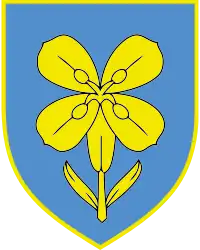Gospić
Gospić (Croatian pronunciation: [ɡǒːspitɕ]) is a town in the mountainous and sparsely populated region of Lika, Croatia. It is the administrative center of Lika-Senj County. Gospić is located near the Lika River in the middle of a karst field (Ličko Polje).
Gospić | |
|---|---|
| Grad Gospić Town of Gospić | |
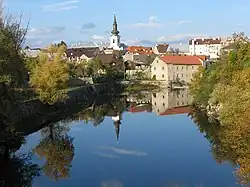 View of Gospić | |
 Flag | |
 Gospić Location of Gospić within Croatia | |
| Coordinates: 44.546°N 15.375°E | |
| Country | |
| County | |
| Government | |
| • Mayor | Karlo Starčević (HSP) |
| Area | |
| • Town | 967.4 km2 (373.5 sq mi) |
| • Urban | 21.4 km2 (8.3 sq mi) |
| Elevation | 656 m (2,152 ft) |
| Population (2021)[2] | |
| • Town | 11,502 |
| • Density | 12/km2 (31/sq mi) |
| • Urban | 6,362 |
| • Urban density | 300/km2 (770/sq mi) |
| Time zone | UTC+01 (CET) |
| Postal code | 53 000 |
| Area code | 053 |
| Vehicle registration | GS |
| Website | gospic |
Gospić is the third smallest seat of a county government in Croatia. Its status as the county capital helped to spur some development in it, but the town as well as the entire region have suffered a constant decrease in population over the last several decades. Scientist and inventor Nikola Tesla was born in the nearby village of Smiljan and grew up in Gospić.
Municipality
- Aleksinica, population 169
- Barlete, population 28
- Bilaj, population 162
- Brezik, population 25
- Brušane, population 134
- Budak, population 151
- Bužim, population 74
- Debelo Brdo I, population 61
- Debelo Brdo II, population 8
- Divoselo, population 4
- Donje Pazarište, population 125
- Drenovac Radučki, population 0
- Gospić, population 6,575
- Kalinovača, population 94
- Kaniža Gospićka, population 401
- Klanac, population 100
- Kruščica, population 0
- Kruškovac, population 20
- Kukljić, population 13
- Lički Čitluk, population 4
- Lički Novi, population 298
- Lički Osik, population 1,914
- Lički Ribnik, population 93
- Mala Plana, population 7
- Medak, population 62
- Mogorić, population 110
- Mušaluk, population 228
- Novoselo Bilajsko, population 112
- Novoselo Trnovačko, population 84
- Ornice, population 6
- Ostrvica, population 16
- Oteš, population 99
- Pavlovac Vrebački, population 33
- Počitelj, population 4
- Podastrana, population 51
- Podoštra, population 177
- Popovača Pazariška, population 93
- Rastoka, population 33
- Rizvanuša, population 29
- Smiljan, population 418
- Smiljansko Polje, population 135
- Široka Kula, population 116
- Trnovac, population 96
- Vaganac, population 30
- Velika Plana, population 52
- Veliki Žitnik, population 47
- Vranovine, population 43
- Vrebac, population 44
- Zavođe, population 4
- Žabica, population 163
| population | 32381 | 33164 | 31371 | 34376 | 38103 | 35380 | 35600 | 35312 | 26920 | 26285 | 27390 | 26683 | 23285 | 22026 | 12980 | 12745 | 11502 |
| 1857 | 1869 | 1880 | 1890 | 1900 | 1910 | 1921 | 1931 | 1948 | 1953 | 1961 | 1971 | 1981 | 1991 | 2001 | 2011 | 2021 |
History
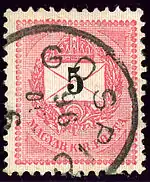
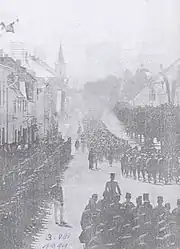
The first organised inhabitation of the area was recorded in 1263 as Kaseg or Kasezi. The name Gospić is first mentioned in 1604, which likely originates from the Croatian word for "lady" (gospa) or another archaic form, gospava. It was ruled by Ottoman Empire as part of Sanjak of Lika initially in Rumeli Eyalet (1528–1580), later in Bosnia Eyalet (1580–1686).
Today's town was built around two Ottoman forts (the towers of Aga Senković and of Aga Alić). The Turkish incursion was repelled by the end of the 17th century and Gospić became an administrative centre of the Lika region within the Military Frontier.
Until 1918, Gospić (named GOSPICH before 1850) was part of the Austrian monarchy (Kingdom of Croatia-Slavonia after the compromise of 1867), in the Croatian Military Frontier, Likaner Regiment N° I.[3] In the late 19th century and early 20th century, Gospić was part of the Lika-Krbava County of the Kingdom of Croatia-Slavonia.
During the Genocide of Serbs by the Ustaše in WWII, the district of Gospić experienced the first large-scale massacres which occurred in the Lika region, as some 3,000 Serb civilians were killed between late July and early August 1941.[4] A concentration camp was established in Gospić in which (together with other camps that belonged to the same complex) the Ustaše might have killed between 24,000-42,000 people, most of them being Serbs and Jews, but some of the prisoners were also Croatian.[5][6]
In the 1990s, during the course of the Croatian War of Independence, Gospić suffered greatly during the Battle of Gospić. The town was held by Croatian government forces throughout the war, while the rebel Serb forces of the Republic of Serbian Krajina occupied positions directly to the east and often bombarded the town from there. In February 1992, a statue of the Serb scientist Nikola Tesla in downtown Gospić was destroyed in an explosion. The perpetrators were never apprehended.[7] The town was the site of the Gospić massacre, where between 100-120 predominantly Serb civilians were killed by Croatian military units.[8] Control of the area finally devolved to the Croatian government with the success of Operation Storm in August 1995.[8]
Gospić is also the site of one of the regional branches of the Croatian State Archives, the Državni arhiv Gospić, at Kaniška 17. It was founded 30 September 1999 and officially opened 1 September 2000 in a renovated building and now houses historical documents of relevance to the Lika-Senj region which were formerly housed in the Regional Archive at Karlovac. In 2013, Croatian Prime Minister Zoran Milanović urged the town's authorities to allow for a replica of the Tesla statue that had been destroyed in 1992 to be reinstated. The mayor of Gospić, Milan Kolić, refused to give his approval for such a move and instead vowed to erect a statue of wartime Croatian President Franjo Tuđman on the spot where the Tesla statue had once stood.[7]
People
- Šime Starčević, priest and linguist
- Josip Filipović, Austro-Hungarian general
- Ante Starčević, politician and writer
- Ferdinand Kovačević, engineer and inventor
- Nikola Tesla, scientist and inventor
- Miroslav Kraljević, painter
- Marko Orešković, Partisan and People's Hero of Yugoslavia
- Kata Pejnović, feminist and politician
- Edo Kovačević, artist
- Milan Mandarić, businessman
- Josip Čorak, wrestler
- Nikica Valentić, politician
- Darko Milinović, gynecologist and politician
- Nikoslav Bjegović, Serbian professional footballer
- Dušan Dragosavac, Croatian Serb politician who served as President of the League of Communists of Yugoslavia
- Predrag Šuput, Serbian basketball player
- Jakov Blažević
Gallery
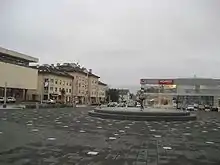 Ante Starčević Square
Ante Starčević Square Defenders memorial
Defenders memorial Nikola Tesla Memorial Center in the nearby village of Smiljan
Nikola Tesla Memorial Center in the nearby village of Smiljan Annunciation of the Blessed Virgin Mary cathedral
Annunciation of the Blessed Virgin Mary cathedral Vila Velebita Fountain
Vila Velebita Fountain Cardinal Alojzije Stepinac bust in city park
Cardinal Alojzije Stepinac bust in city park Kolakovac park
Kolakovac park Coffeehouse in the town centre
Coffeehouse in the town centre Nikola Tesla statue
Nikola Tesla statue Pope John Paul II bust
Pope John Paul II bust
Climate
Gospić has a humid continental climate, Dfb by Köppen climate classification, with mean temperatures varying from −0.9 °C (30.4 °F) in January to 18.1 °C (64.6 °F) in July. Being situated higher than 500 metres (1,640 ft) above sea level, the area experiences high diurnal ranges, especially in summer, and frost has been recorded in every month except for July. The record low and high temperatures are −33.5 °C (−28.3 °F) and 38.7 °C (101.7 °F), respectively. Gospić is also quite a rainy city, with a slight summer minimum, but it experiences plentiful precipitation all year long, with the maximum being in autumn. During winter, Gospić can get strong blizzards, with on average 5.1 days a year when more than 50 cm (20 in) falls, and 16.1 days when more than 30 cm (12 in) falls. Its record snow cover was 285 cm (112.2 in), and it was measured in February 1916.
| Climate data for Gospić (1971–2000, extremes 1872–2015) | |||||||||||||
|---|---|---|---|---|---|---|---|---|---|---|---|---|---|
| Month | Jan | Feb | Mar | Apr | May | Jun | Jul | Aug | Sep | Oct | Nov | Dec | Year |
| Record high °C (°F) | 16.0 (60.8) |
20.1 (68.2) |
23.4 (74.1) |
27.9 (82.2) |
31.6 (88.9) |
35.4 (95.7) |
38.7 (101.7) |
37.2 (99.0) |
33.3 (91.9) |
28.8 (83.8) |
25.7 (78.3) |
16.9 (62.4) |
38.7 (101.7) |
| Average high °C (°F) | 3.3 (37.9) |
5.4 (41.7) |
9.7 (49.5) |
13.5 (56.3) |
19.0 (66.2) |
22.5 (72.5) |
25.2 (77.4) |
25.4 (77.7) |
20.8 (69.4) |
15.3 (59.5) |
8.5 (47.3) |
3.9 (39.0) |
14.4 (57.9) |
| Daily mean °C (°F) | −0.8 (30.6) |
0.3 (32.5) |
4.1 (39.4) |
8.0 (46.4) |
13.0 (55.4) |
16.3 (61.3) |
18.5 (65.3) |
17.9 (64.2) |
13.6 (56.5) |
9.1 (48.4) |
3.8 (38.8) |
0.0 (32.0) |
8.7 (47.7) |
| Average low °C (°F) | −5.0 (23.0) |
−4.2 (24.4) |
−1.1 (30.0) |
2.5 (36.5) |
6.5 (43.7) |
9.4 (48.9) |
10.9 (51.6) |
10.5 (50.9) |
7.5 (45.5) |
4.1 (39.4) |
−0.4 (31.3) |
−3.7 (25.3) |
3.1 (37.6) |
| Record low °C (°F) | −32.6 (−26.7) |
−33.5 (−28.3) |
−23.6 (−10.5) |
−10.5 (13.1) |
−7.0 (19.4) |
−1.8 (28.8) |
2.4 (36.3) |
0.0 (32.0) |
−5.6 (21.9) |
−13.7 (7.3) |
−23.2 (−9.8) |
−27.0 (−16.6) |
−33.5 (−28.3) |
| Average precipitation mm (inches) | 101.8 (4.01) |
98.8 (3.89) |
95.2 (3.75) |
108.9 (4.29) |
108.4 (4.27) |
95.4 (3.76) |
60.4 (2.38) |
83.1 (3.27) |
140.4 (5.53) |
156.5 (6.16) |
175.4 (6.91) |
141.9 (5.59) |
1,365.9 (53.78) |
| Average precipitation days (≥ 0.1 mm) | 12.7 | 11.6 | 12.4 | 13.8 | 13.2 | 11.9 | 8.3 | 8.2 | 11.2 | 12.4 | 13.8 | 13.5 | 143.0 |
| Average snowy days (≥ 1.0 cm) | 16.0 | 14.5 | 9.1 | 2.6 | 0.2 | 0.0 | 0.0 | 0.0 | 0.0 | 0.3 | 6.5 | 16.0 | 65.2 |
| Average relative humidity (%) | 84.3 | 79.9 | 74.8 | 72.5 | 72.5 | 72.3 | 70.3 | 73.0 | 78.9 | 81.2 | 84.1 | 86.2 | 77.5 |
| Mean monthly sunshine hours | 68.2 | 101.7 | 145.7 | 165.0 | 226.3 | 249.0 | 303.8 | 272.8 | 192.0 | 130.2 | 69.0 | 55.8 | 1,979.5 |
| Percent possible sunshine | 25 | 38 | 43 | 44 | 54 | 59 | 70 | 67 | 55 | 42 | 27 | 21 | 48 |
| Source: Croatian Meteorological and Hydrological Service[9][10] | |||||||||||||
Demographics
| Ethnic group | 1948 | 1953 | 1961 | 1971 | 1981 | 1991[11] | 2001[12] | 2011[13] |
|---|---|---|---|---|---|---|---|---|
| Croats | 24,307 (65.02%) | 18,525 (59.25%) | 18,613 (64.07%) | 12,050 (92.84%) | 11,860 (93.06%) | |||
| Serbs | 11,801 (31.56%) | 9,283 (29.69%) | 8,976 (30.89%) | 625 (4.82%) | 609 (4.78%) | |||
| Yugoslavs | 635 (1.69%) | 2,907 (9.29%) | 513 (1.76%) | |||||
| Others | 640 (1.71%) | 548 (1.75%) | 947 (3.26%) | 305 (2.35%) | ||||
| Total[14] | 26,920 | 26,285 | 27,390 | 37,383 | 31,263 | 29,049 | 12,980 | 12,745 |
| 1948 | 1953 | 1961 | 1971 | 1981 | 1991[11] | 2001[12] | 2011[13] |
|---|---|---|---|---|---|---|---|
| 4,204[14] | 5,127[14] | 6,767[14] | 8,046[14] | 8,725[14] | 9,025 | 6,088 | 5,795 |
Politics
Minority councils and representatives
Directly elected minority councils and representatives are tasked with consulting tasks for the local or regional authorities in which they are advocating for minority rights and interests, integration into public life and participation in the management of local affairs.[15] At the 2023 Croatian national minorities councils and representatives elections Serbs of Croatia fulfilled legal requirements to elect 15 members minority council of the Town of Gospić with only 13 members being elected in the end.[16]
References
- Register of spatial units of the State Geodetic Administration of the Republic of Croatia. Wikidata Q119585703.
- "Population by Age and Sex, by Settlements, 2021 Census". Census of Population, Households and Dwellings in 2021. Zagreb: Croatian Bureau of Statistics. 2022.
- Handbook of Austria and Lombardy-Venetia Cancellations on the Postage Stamp Issues 1850–1864, by Edwin MUELLER, 1961.
- Biondich, Mark (2011). The Balkans: Revolution, War, and Political Violence Since 1878. Oxford University Press. pp. 136–137. ISBN 978-0-19929-905-8.
- Israeli, Raphael (4 March 2013). The Death Camps of Croatia: Visions and Revisions, 1941–1945. Transaction Publishers. p. 77. ISBN 978-1-4128-4930-2.
- Radovi (Filozofski Fakultet Zagreb. Humanisticke i Drustvene Znanosti). Zavod. 2007. p. 355.
Procjenjuje se daje u logorskom kompleksu Gospić-Velebit-Pag (Mirko Peršen, Đuro Zatezalo, Ilija Jakovljević) pogubljeno oko 24.000 ljudi.
- Pavelic, Boris (23 January 2013). "Bring Nikola Tesla Monument Back, Urges Croatia PM". Balkan Insight. Retrieved 24 January 2020.
- Schäuble, Michaela (2014). Narrating Victimhood: Gender, Religion and the Making of Place in Post-War Croatia. Berghahn Books. p. 317. ISBN 9781782382614.
- "Gospić Climate Normals" (PDF). Croatian Meteorological and Hydrological Service. Archived from the original (PDF) on 3 March 2016. Retrieved 3 December 2015.
- "Mjesečne vrijednosti za Gospić u razdoblju1872−2015" (in Croatian). Croatian Meteorological and Hydrological Service. Archived from the original on 17 November 2018. Retrieved 16 July 2017.
- "Naselja i stanovništvo RH od 1857–2001. godine", Izdanje Državnog zavoda za statistiku Republike Hrvatske, Zagreb, 2005.
- "2001 census by settlement". Central Bureau of Statistics (Croatia) (in Croatian). 31 March 2001. Retrieved 17 September 2010.
- "Population by Age and Sex, by Settlements, 2011 Census: Gospić". Census of Population, Households and Dwellings 2011. Zagreb: Croatian Bureau of Statistics. December 2012.
- Croatia censuses 1948–1991
- "Manjinski izbori prve nedjelje u svibnju, kreću i edukacije". T-portal. 13 March 2023. Retrieved 10 June 2023.
- "Informacija o konačnim rezultatima izbora članova vijeća i izbora predstavnika nacionalnih manjina 2023. IX. LIČKO-SENJSKA ŽUPANIJA" (PDF) (in Croatian). Državno izborno povjerenstvo Republike Hrvatske. 2023. p. 4. Retrieved 13 June 2023.
